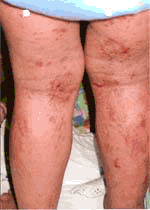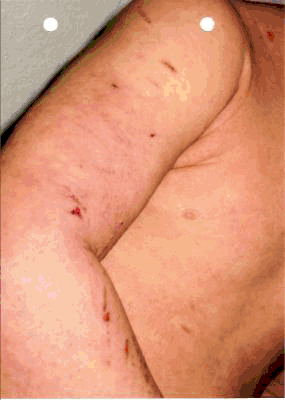 Atopic dermatitis (AD) is a chronic skin disorder that causes dry, itching, and inflamed skin. The rash of atopic dermatitis comes and goes.
Atopic dermatitis (AD) is a chronic skin disorder that causes dry, itching, and inflamed skin. The rash of atopic dermatitis comes and goes.
The term eczema is sometimes used to describe atopic dermatitis. Eczema refers to inflamed, itching skin from a variety of causes. Atopic dermatitis is the most common type of eczema.
Images: Before & After Treatment for Atopic Dermatitis
Atopic dermatitis is very common, affecting 10-15% of people. The severe itching and irritation during flare-ups can be extremely bothersome. The resulting scratching can result in raw skin and skin infections.
Fortunately, most cases of atopic dermatitis respond well to treatment.
What are the symptoms of atopic dermatitis?
The most obvious symptoms of atopic dermatitis are intense itching, along with red, dry skin that is sometimes scaly.
The worsening of atopic dermatitis symptoms is referred to as a "flare". An atopic dermatitis flare can be triggered by a variety of factors (see below).
The appearance of atopic dermatitis varies tremendously from person to person. Most people with atopic dermatitis experience a short-term flare for a few weeks (acute), during which the skin looks red, raised, and cracked.
Between flares, the skin may appear normal or slightly dry. If the rash lasts a long time (chronic), the skin may start to change appearance, becoming thicker and darker. These patches of thickened skin take longer to respond to treatment.
The appearance of atopic dermatitis also tends to vary depending on the age of the person.
Atopic Dermatitis in Infants
Children less than one year old often have atopic dermatitis widely distributed over their body. The skin is usually dry, scaly, and red. The baby may scratch the skin, leading to scratch marks. The cheeks of infants are often the first place to be affected.
The diaper area is frequently spared because the moisture retained by the diapers prevents the skin from drying.
Atopic Dermatitis in Toddlers
As children reach 2 to 3 years old, atopic dermatitis becomes more localized to areas such as the outer part of the joint, including the front of the knees, outside elbows, and top of the wrists. Older children are also more capable of a vigorous scratch, creating very red and inflamed areas.
Atopic Dermatitis in School-age Children
As children reach school age, atopic dermatitis tends to migrate to the part of the joint that flexes, such as the insides of the elbows and knees. atopic dermatitis may also start to appear on the eyelids, earlobes, neck, and scalp.
School-age children may develop itchy blisters on the fingers and feet known as dyshidrotic or vesicular dermatitis (pompholyx).
Atopic Dermatitis in Adults
Adults with atopic dermatitis tend to have the rash localized to specific areas, particularly the hands, feet, eyelids, back of the knees, and insides of the elbows. However, the skin elsewhere on the body may feel dry and prone to itching.
Atopic dermatitis that starts in infancy often improves by the time the child is 5 years old and usually resolves by the teenage years. However, many people endure atopic dermatitis and need to manage it throughout their lives.
What causes atopic dermatitis?
The exact cause of atopic dermatitis is unknown, but the tendency to develop atopic dermatitis runs in families. People with atopic dermatitis are more likely to suffer allergies and/or symptoms of asthma. The connection between these disorders appears to be an overactive immune system.
T-cells, a type of white blood cell that fights infections, appear to be more active in people with atopic dermatitis. Changes beneath the skin make the skin of people with atopic dermatitis more susceptible to losing water quickly, leading to dry, cracked skin.
Although the immune system is overactive in people with atopic dermatitis, it is not always effective at fighting infections. In fact, people with atopic dermatitis are more susceptible to skin infections, such as impetigo.
What are the treatment options for atopic dermatitis?
The goals of atopic dermatitis treatment are to heal the skin, prevent new flare-ups, and reduce the urge to scratch, which can further irritate and prolong symptoms.
Atopic dermatitis treatment may last for many months, and treatments often need to be repeated.
There are several treatment options available. A treatment plan will be recommended based on several variables, including:
- The person's age
- The location of the rash (face vs. knee)
- The severity of the flare
- Acute vs. chronic (long-lasting symptoms may require more potent medications)
- Results of past treatments
- Personal preferences
It is generally recommended that all people with atopic dermatitis do their best to avoid known triggers and apply a moisturizer regularly.
Additional treatment options include:
- Topical corticosteroids. Mild to mid-potency corticosteroids are applied to the skin on a short-term basis to bring the flare under control
- Calcineurin inhibitors. Calcineurin inhbitors are non-steroidal medications may be used as an alternative to corticosteroids or in between use of corticosteroids. They too help to reduce inflammation.
- Antihistamines. Antihistamines help to reduce the itching and scratching that can prevent the skin from healing
- Antibiotics. These may be prescribed to treat an underlying bacterial infection of the skin that can be worsening symptoms of atopic dermatitis.
- Oral corticosteroids (prednisone). These may be used to bring severe cases of atopic dermatitis under control quickly. Due to the wide variety of side effects caused by oral corticosteroids, they are generally prescribed for only a few days.
- Immunosuppressants (cyclosporine). These may be considered for severe cases of atopic dermatitis that do not respond to other treatments.
- Biologic medications (dupilumab). These medications reduce inflammation and lessen the symptoms of atopic dermatitis.
What triggers atopic dermatitis?
Not everyone with atopic dermatitis will have the same triggers, so people with the disorder will have to keep track of their particular sensitivities. Because identifying triggers can be tricky (for example, sometimes there is a delay between eating a certain food and seeing a resulting flare-up), it’s a good idea to keep a journal of any atopic dermatitis symptoms and possible causes.
Some commonly reported atopic dermatitis triggers include:
- Irritants—These are substances that contact the skin directly, causing redness and inflammation. They include wool or other synthetic fabrics, soaps and detergents, perfumes and makeup, cigarette smoke, and chemicals (such as chlorine).
- Allergens—Allergens are more indirect triggers, where the skin becomes inflamed and itchy because of an allergic reaction, such as from pollen, mold, or animal and pet dander.
- Stress—While stress isn’t a known cause of atopic dermatitis, it can aggravate flare-ups.
- Temperature—Many people with atopic dermatitis have chronically dry skin that is sensitive to certain climate conditions, such as cold winter weather, indoor heating, or warm baths. Humid environments, such as a sauna, may cause sweating that could trigger a flare-up.
How can I prevent atopic dermatitis flare-ups?
Basic skin care measures may help to prevent atopic dermatitis flare-ups.
Source: Vivacare
Last updated : 5/13/2022